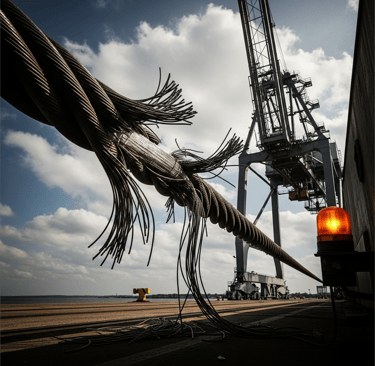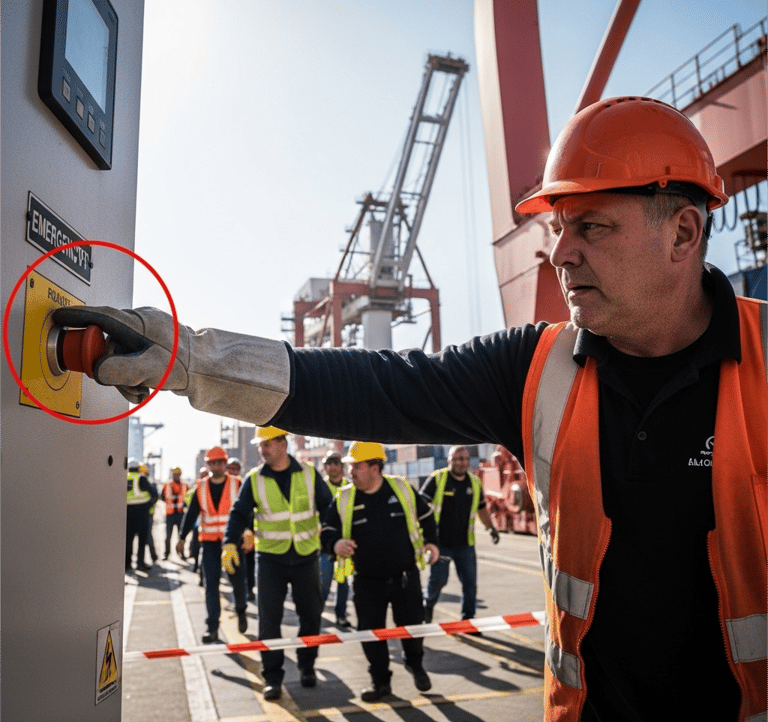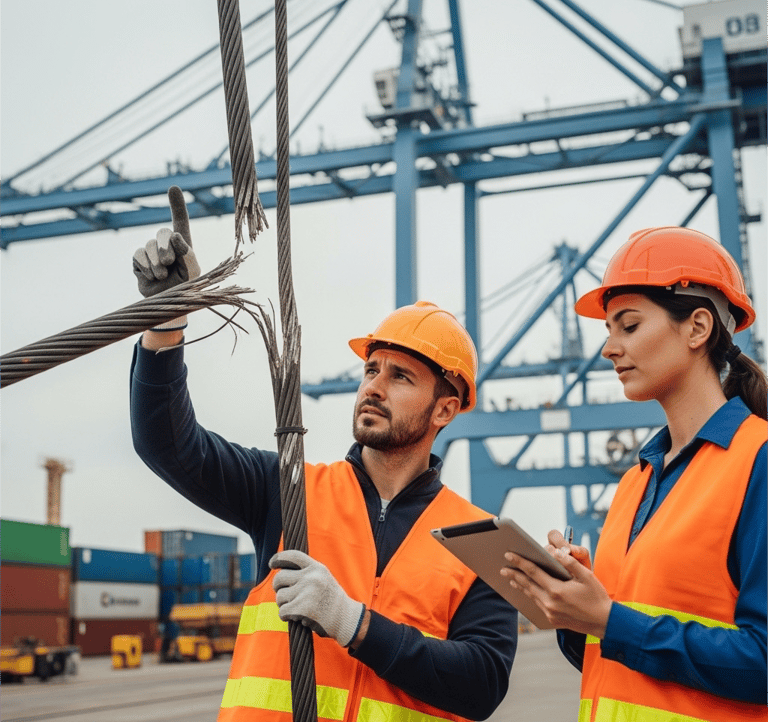📞+86 153 7530 2641 📧 hongjing.Wang@feichuncables.com
What Should You Do Immediately If a Port Crane Cable Is Accidentally Severed?
A port crane cable has been accidentally severed—what now? Learn the expert-approved emergency response steps to follow immediately after a cable failure. This guide helps ensure worker safety, reduce downtime, and support compliance at harbor operations.
hongjing.Wang@Feichun
7/14/2025
Introduction
Port crane cables form the backbone of modern harbor operations, serving as the critical connection between massive lifting equipment and the cargo containers that fuel global trade. These specialized cables must withstand enormous loads, harsh marine environments, and constant mechanical stress while maintaining precise control over multi-ton loads. When a port crane cable is accidentally severed, the consequences extend far beyond simple equipment downtime—they can threaten worker safety, disrupt supply chains, and result in significant financial losses for terminal operators.
The implications of cable failure in harbor operations are severe and multifaceted. Beyond the immediate safety hazards posed by uncontrolled loads and electrical dangers, a severed cable can halt entire sections of port operations, creating bottlenecks that affect shipping schedules worldwide. Maritime terminals operate on tight schedules where every minute of downtime translates to lost revenue and potential contractual penalties. Furthermore, the complex nature of port crane systems means that cable damage can cascade into other operational issues, affecting everything from container positioning accuracy to the integrity of nearby infrastructure.
This comprehensive guide addresses the critical emergency response procedures that must be implemented immediately following a cable failure incident. The following sections will outline the recognition of cable damage, immediate safety protocols, notification procedures, damage assessment techniques, temporary safety measures, repair processes, documentation requirements, and long-term preventive strategies. Each step is designed to minimize risks, protect personnel, and restore operations as quickly and safely as possible while maintaining compliance with maritime safety regulations and industry best practices.


How Do You Recognize a Severed Port Crane Cable?
Identifying a severed port crane cable requires understanding both the visual indicators and system feedback that signal cable integrity compromise. The most obvious visual cues include complete cable separation, where the cable appears physically broken or hanging loose from its intended path. However, partial severing can be more dangerous as it may not be immediately apparent while still compromising the cable's load-bearing capacity and safety margins.
System alerts provide the first line of detection for cable problems. Modern harbor crane systems incorporate sophisticated monitoring equipment that continuously tracks cable tension, electrical continuity, and mechanical performance. When a cable is severed, operators typically receive immediate alerts through control panel indicators, audible alarms, and computer-based monitoring systems. These alerts may include loss of load feedback, electrical circuit interruptions, or abnormal tension readings that indicate compromised cable integrity.
Operator feedback serves as another crucial detection method, particularly for experienced crane operators who understand the normal feel and response of their equipment. When a cable is damaged, operators often report unusual mechanical resistance, erratic load behavior, or changes in the crane's responsiveness to control inputs. The lifting mechanism may exhibit jerky movements, fail to respond to commands, or demonstrate inconsistent load positioning that suggests cable problems.
Early warning signs of strain in harbor crane cable systems include fraying at connection points, unusual cable positioning or routing, excessive vibration during operation, and gradual changes in system performance over time. Visual inspection may reveal surface damage, corrosion, or wear patterns that indicate impending failure. These signs often appear days or weeks before complete failure, making regular inspection protocols essential for preventing emergency situations.
What Immediate Actions Should Be Taken Within the First 5 Minutes?
The first five minutes following the discovery of a severed port crane cable are critical for preventing injuries and minimizing damage. The immediate priority is to shut down crane operation instantly using the emergency stop systems. This action prevents further damage to the cable system and eliminates the risk of uncontrolled load movement that could endanger personnel or damage cargo and infrastructure.
Securing the work area and evacuating staff represents the second critical action. All personnel within the crane's operational radius must be immediately moved to safe zones, typically marked areas that are beyond the reach of potential falling loads or swinging equipment. This evacuation should follow predetermined emergency protocols that designate specific rally points and evacuation routes. The affected area should be cordoned off using barriers, cones, or other visual markers to prevent unauthorized access.
Disabling power and engaging emergency stop systems ensures that the crane cannot be accidentally restarted during the emergency response. This includes activating lockout/tagout procedures that physically prevent equipment energization. Emergency stop systems should be engaged at multiple levels, including the main control panel, individual crane controls, and facility-wide emergency systems if the situation warrants such action.
Additional immediate actions include establishing communication with the port control center, ensuring that emergency response teams are alerted, and beginning documentation of the incident timeline. The crane operator should remain at their station only long enough to safely shut down systems and should then evacuate to the designated safe area. All these actions must be completed rapidly but methodically to ensure nothing is overlooked in the urgency of the moment.
Who Should Be Notified First?
The notification hierarchy following a port crane cable incident must be swift and comprehensive to ensure appropriate response and compliance with safety regulations. The port safety supervisor should be the first contact, as this individual has the authority to coordinate emergency response efforts and make critical decisions about facility operations. The safety supervisor can assess the broader implications of the incident and determine whether additional emergency measures are required.
The technical team responsible for crane maintenance and repair should be notified immediately after the safety supervisor. This team includes mechanical engineers, electrical specialists, and cable system experts who can provide immediate technical guidance and begin mobilizing repair resources. Their expertise is essential for initial damage assessment and for determining whether the incident poses additional risks to other equipment or personnel.
Crane manufacturer representatives may need to be contacted if the incident involves complex technical issues or if warranty considerations apply. Many manufacturers provide 24-hour emergency support for critical equipment failures and can offer remote diagnostic assistance or expedited parts delivery. Their involvement is particularly important for newer equipment or when the failure mode is unusual or unexpected.
Internal communication checklist should include department heads, shift supervisors, cargo operations coordinators, and facility management. Each of these stakeholders plays a role in managing the operational impacts of the incident and coordinating alternative arrangements for cargo handling. The port authority's operations center should also be notified to ensure awareness of potential delays or operational changes.
External stakeholders requiring notification include insurance carriers, regulatory agencies if required by local laws, and shipping lines whose cargo operations may be affected. Customer service representatives should be prepared to communicate with affected shipping companies about potential delays or alternative arrangements. Documentation of all notifications, including timestamps and recipient responses, should be maintained for incident reporting purposes.






How Is the Damage Assessed?
Professional damage assessment begins with involving qualified cable engineers or certified inspectors who possess the specialized knowledge required to evaluate harbor crane cable systems. These professionals understand the specific requirements of marine-grade cables, load-bearing specifications, and the complex interactions between different cable types within the crane system. Their assessment must be comprehensive, covering not only the obviously damaged cable but also evaluating potential secondary damage to related components.
The evaluation process extends beyond the severed cable to include nearby cables such as fiber-optic communication lines, marine-grade power cables, and reeling cables that may have been affected by the incident. Cable systems in port cranes often operate in close proximity, and damage to one cable can create stress or damage in adjacent systems. This comprehensive evaluation prevents secondary failures that could occur if damaged cables are overlooked during the initial assessment.
Understanding the functional impact of the damage is crucial for determining repair priorities and operational alternatives. The assessment must determine whether the damage affects data transmission capabilities, load-bearing functions, or control system operations. Each type of damage has different implications for safety and operations, requiring different repair approaches and timelines. Data transmission issues might allow for temporary workarounds, while load-bearing damage requires immediate and complete repair before operations can resume.
The assessment process also involves documenting the failure mode, which provides valuable information for preventing future incidents. This documentation should include photographs of the damaged cable, measurements of the affected area, analysis of the failure mechanism, and evaluation of environmental factors that may have contributed to the failure. This information becomes essential for insurance claims, regulatory reporting, and long-term maintenance planning.
Can You Implement Temporary Safety Measures?
Temporary safety measures serve as critical interim solutions while permanent repairs are planned and executed. Emergency lifting alternatives may include deploying mobile cranes, using adjacent port crane systems, or implementing manual handling procedures for smaller loads. These alternatives must be carefully evaluated to ensure they can safely handle the required loads and operate within the constraints of the port environment.
Cordon-off procedures and signage create physical barriers that prevent unauthorized access to the affected area while allowing necessary personnel to perform assessment and repair work. These barriers should be clearly marked with appropriate safety signage indicating the nature of the hazard and the restricted access requirements. The cordoned area should be sufficiently large to account for potential equipment movement during repair operations.
Pre-installed safety gear for secondary lifting includes backup cables, emergency load-securing devices, and alternative control systems that may be activated in case of primary system failure. Many modern harbor crane installations include redundant safety systems specifically designed to handle emergency situations. These systems should be tested and verified operational before relying on them during the emergency response.
Additional temporary measures may include implementing modified operational procedures, adjusting cargo handling schedules to work around the damaged equipment, and establishing alternative workflow patterns that minimize disruption to port operations. These measures require coordination with multiple stakeholders and may involve temporary changes to standard operating procedures.
How is the Port Crane Cable Repaired or Replaced?
The repair or replacement process begins with safe cable removal, which requires careful planning to prevent additional damage to the crane system or injury to personnel. The removal process typically involves relieving tension from the damaged cable, disconnecting electrical and mechanical connections, and carefully extracting the cable from the crane's routing system. This process must be performed by qualified technicians using appropriate safety equipment and following manufacturer-specific procedures.
Choosing the right replacement port crane cable involves matching specifications for load capacity, marine protection, and flexibility requirements. The replacement cable must meet or exceed the original specifications for electrical conductivity, mechanical strength, and environmental resistance. Marine-grade cables require special attention to corrosion resistance and waterproofing capabilities that are essential for harbor operations.
The installation process involves routing the new cable through the crane's system, making secure electrical and mechanical connections, and adjusting tension to manufacturer specifications. This process requires specialized tools and expertise to ensure proper installation and avoid damage to the new cable during installation. Proper cable routing is essential to prevent interference with other systems and to ensure smooth operation throughout the crane's range of motion.
Testing the new cable involves comprehensive verification of all system functions, including load testing, electrical continuity verification, and operational testing throughout the crane's full range of motion. This testing must be performed according to manufacturer specifications and industry standards before the crane can be returned to service. The testing process should be documented to provide verification of proper installation and system integrity.
What Documentation and Reporting Are Required?
Comprehensive incident documentation begins with writing a full incident report that includes technical findings, timeline of events, and analysis of contributing factors. This report must be detailed enough to satisfy regulatory requirements while providing valuable information for preventing future incidents. The report should include witness statements, technical analysis, and recommendations for preventing similar occurrences.
Compliance with port authority and insurance requirements involves submitting specific documentation within mandated timeframes. Port authorities typically require notification within hours of the incident, followed by detailed reports within days or weeks. Insurance carriers require comprehensive documentation to process claims and may require independent technical assessments of the damage and repair costs.
Analysis of failure mode requires detailed technical investigation to determine whether the incident resulted from mechanical stress, corrosion, installation error, or other factors. This analysis should include examination of maintenance records, operational logs, and environmental conditions that may have contributed to the failure. Understanding the failure mode is essential for implementing effective preventive measures and may reveal systemic issues that require broader attention.
The documentation process should also include cost analysis of the incident, including direct repair costs, operational downtime losses, and potential liability issues. This information is valuable for insurance purposes and for making business decisions about future equipment investments and maintenance strategies.
What Preventive Measures Should Be Adopted?
Implementing routine inspections and predictive maintenance represents the most effective approach to preventing cable failures in harbor crane systems. Regular visual inspections should be supplemented with advanced diagnostic techniques such as electrical testing, tension monitoring, and vibration analysis. These inspections should be scheduled based on manufacturer recommendations, operational intensity, and environmental conditions.
Training staff in emergency response and cable awareness ensures that personnel can recognize early warning signs of cable problems and respond appropriately to emergency situations. This training should cover proper inspection techniques, emergency response procedures, and the importance of reporting unusual observations. Regular drills and training updates help maintain preparedness and ensure that all personnel understand their roles during emergency situations.
Monitoring systems for early warning of cable fatigue utilize advanced sensor technology to continuously track cable condition and performance. These systems can detect gradual changes in cable properties that indicate developing problems before they result in failure. Early warning systems allow for planned maintenance and cable replacement, avoiding emergency situations and minimizing operational disruption.
Additional preventive measures include maintaining spare cable inventory, establishing relationships with qualified repair contractors, and developing detailed emergency response procedures that are regularly reviewed and updated. These measures create a comprehensive approach to cable management that minimizes the risk of failures and ensures rapid response when problems do occur.
Conclusion
The emergency response to a severed port crane cable requires immediate action, systematic assessment, and comprehensive follow-up to ensure safety and minimize operational disruption. The critical steps outlined in this guide—from initial recognition and immediate shutdown through damage assessment, temporary measures, repair processes, and documentation—form a comprehensive framework for managing these serious incidents effectively.
The key to successful emergency response lies in preparation, training, and maintaining clear procedures that can be implemented quickly under pressure. Port operators must invest in both preventive measures and emergency response capabilities to protect personnel, minimize downtime, and maintain the reliability of harbor operations. The complex nature of modern port crane systems requires specialized expertise and coordinated response efforts that extend beyond simple equipment repair.
Improving cable resilience and minimizing crane downtime requires a proactive approach that combines regular maintenance, advanced monitoring systems, and comprehensive emergency preparedness. By implementing the strategies outlined in this guide, port operators can significantly reduce the risk of cable failures while ensuring rapid and effective response when incidents do occur.
For immediate reference during emergency situations, consider downloading our free Harbor Crane Cable Emergency Checklist PDF, which provides a quick-reference guide to the critical steps outlined in this comprehensive guide. This checklist can be posted in crane operator stations and maintenance areas to ensure that essential emergency procedures are readily available when needed most.
Frequently Asked Questions About Port Crane Cable Emergencies
Q: How quickly must emergency response begin after discovering a severed cable?
A: Emergency response must begin immediately upon discovery, with crane shutdown and area evacuation completed within the first 2-3 minutes to prevent injuries and additional damage.
Q: Can port operations continue using other cranes while one is out of service?
A: Operations may continue with other equipment, but capacity will be reduced and careful coordination is required to prevent bottlenecks and maintain safety standards.
Q: What qualifications are required for personnel conducting cable damage assessment?
A: Assessment should be performed by certified cable engineers or marine equipment specialists with specific training in harbor crane systems and cable technology.
Q: How long does typical cable replacement take for a port crane?
A: Replacement time varies from 8-48 hours depending on cable type, accessibility, and complexity of the installation, plus additional time for testing and commissioning.
Invitation to download a free Harbor Crane Cable Emergency Checklist PDF.
How to Reach Us
Get in Touch
SiteMap
Product Catalogue
Reeling Cable
Festoon Cable
Shore Power Cable




Scan to add us on WeChat
